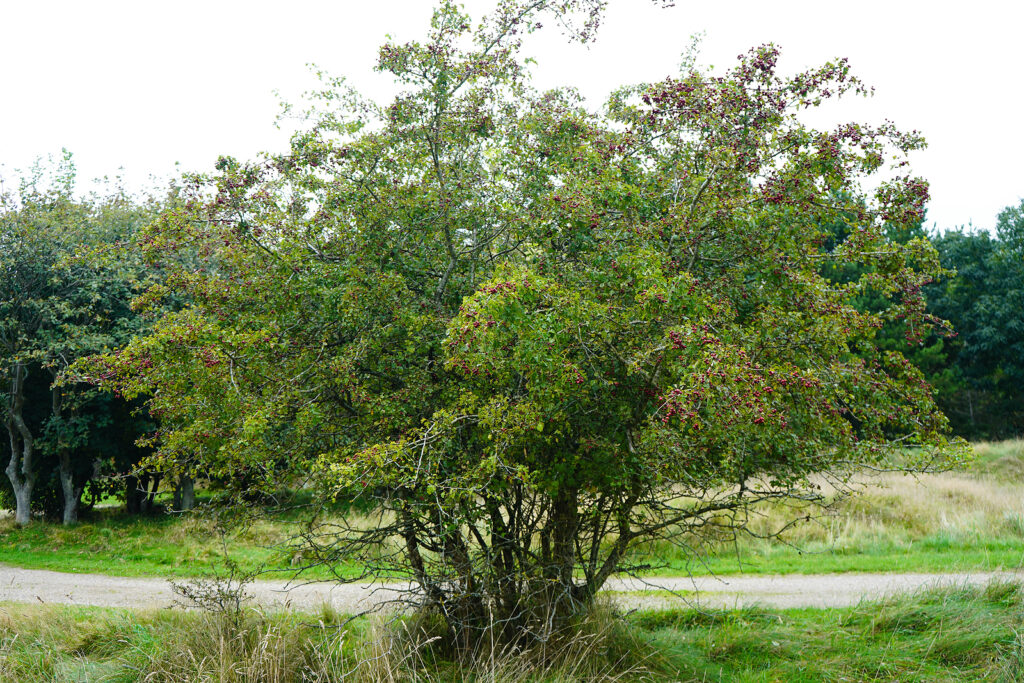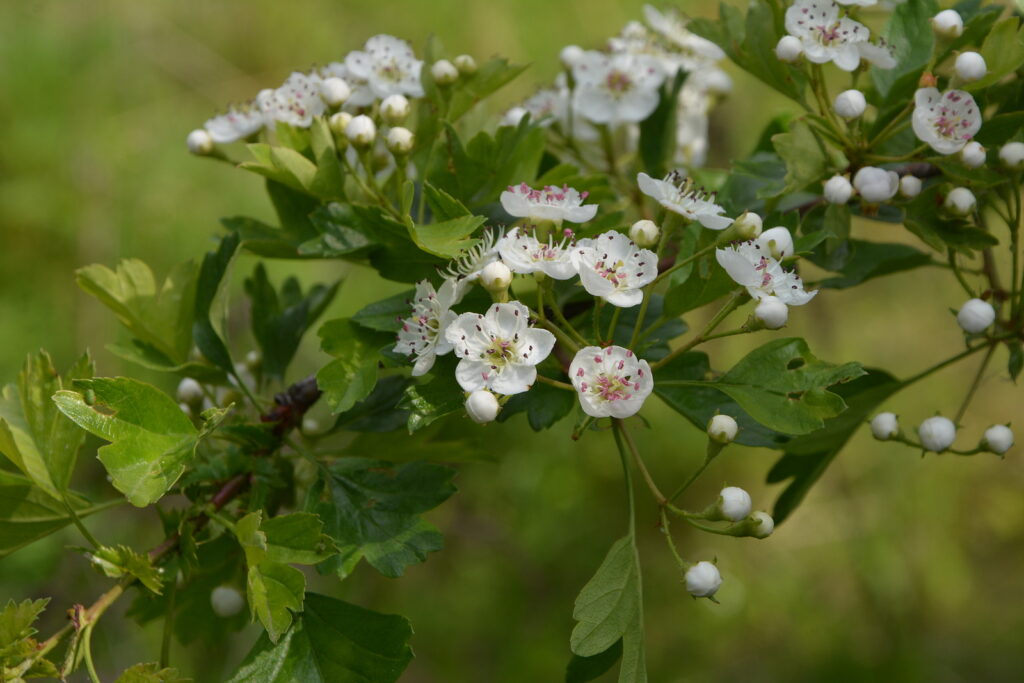Crataegus–commonly called hawthorn–are small trees known for their year-round beauty. They bear white to deep pink five-petaled flowers in dense clusters. Flowers are followed by showy fruit resembling tiny apples in summer and fall, and often into winter.
Crataegus bloom in late spring after most other trees. Paired with early spring bloomers, they increase the spring season of color. Crataegus are typically multi-trunked and some can be thorny. They are useful as specimen trees, for hedging, and for urban, coastal, and exposed gardens.
Crataegus are members of the rose family and so are susceptible to many of the same pest and disease problems of roses. They are deciduous and sometimes semi-evergreen.
Crataegus is a genus of more than 200 species. They are native to woodland and scrub in northern temperate regions.

Get to know Crataegus
- Plant type: Deciduous trees or shrubs
- Growing zones and range: USDA Zones 4 or 5 to 7 or 8
- Hardiness: Hardy to Zone 4
- Height and width: To 20-30 feet (6.1-9.1m) tall and wide
- Growth rate: Medium slow
- Form and habit: Vase-shaped
- Foliage: Typically multitrunked with thorny branches; leaves vary in size, shape and fall coloring from species to species, but all have very sharp thorns that become bone hard; they are alternate, ovate, or obovate, and mid- to dark green
- Flowers: 2-3 inch (5.1-7.6cm) clusters of white, pink, or red flowers less than an inch (2.5cm) across, usually shallow cup-shaped and mostly borne in flat or rounded corymbs at the ends of short, leafy shoots, although (rarely) they may be solitary
- Fruits: Red showy fruit called haws, resembling tiny, less than 1 inch (2.5cm) across, apples in summer and fall, often into winter; consist of fleshy exteriors with bony nutlets
- Bloom time: Late winter to early spring
- Uses: Shade, landscape, hedge, screening, lawn specimen, naturalizing, urban, coastal, or exposed garden
- Garden companions:
- Common name: Hawnthorns
- Botanical name: Crataegus
- Family name: Rosaceae
- Origin: Eastern and central North America
Where to plant Crataegus
- Plant Crataegus in full sun or partial shade.
- Plant Crataegus in well-drained soil; Crataegus will grow in any soil as long as it’s drained, either acid or alkaline.
- Crataegus withstands urban conditions and air pollution.
- Crataegus are remarkably tough trees and can endure seasons of drought and cold as well as the soot and grime of cities.
When to plant Crataegus
- Trees bought balled and burlaped—that is, with their roots in their original soil balled and wrapped in burlap—should be planted only in early spring.
- Sow seed in a seedbed or in containers in an open frame; stratify and sow seed in a seedbed in spring (germination may take 18 months).

Planting and spacing Crataegus
- Buy Crataegus trees no taller than 8 feet (2.4m)—larger trees are difficult to establish in the garden because of their long vertical main roots, or taproots.
- Plant Crataegus 30 feet (10m) apart.
How to water and feed Crataegus
- Give Crataegus moderate water.
- Feed Crataegus with an all-purpose organic fertilizer in spring
How to care for Crataegus
- Crataegus branches need some pruning to thin out excess twiggy growth.
- Because of their dense branching and a natural tendency to multiple trunks, Crataegus are sometimes left unpruned, with the branches close to the ground; but more often they are grown as free-standing trees to decorate a lawn, shade a patio, or adorn a street
- To remove some branches of mature trees in order to let more light pass through, or to remove side branches to provide overhead clearance, prune when the trees are dormant, in winter or very early spring.
- Cut away stems, or suckers, that rise from the roots at any time.
- Trim hedges after flowering in autumn.
Crataegus pests and diseases
- Crataegus are susceptible to attacks by aphids, scale insects, tree borer, caterpillars, leafminers, and skeletonizer.
- Fire blight, cankers, cedar-apple rust, powdery mildew, apple scab, and a variety of fungal spots each occur regularly in some locations.
- Crataegus fruits are moderately susceptible to rust, but leaves are only slightly affected.
- Crataegus are better grown under somewhat austere conditions, since good soil, regular water, and fertilizer all promote succulent new growth that is most susceptible to fireblight
- Fireblight makes entire branches die back quickly; cut out blighted branches well below dead part.
- The rust stage of cedar-apple rust can be a problem wherever Crataegus grows nearby.
- Most Crataegus have sharp spines, sometimes 3 inches (7.6cm) long, and are not recommended for areas frequented by children.

Crataegus propagation
- Remove seed from flesh as soon as ripe.
- Bud cultivars in midsummer, or graft in winter.
Crataegus varieties to grow
- Crataegus arnoldiana, Arnold hawthorn, eventually grows 20-30 feet (6.1-9.1m) tall, its dense zigzag branches lined with 2-3 inch (5.1-7.6cm) thorns. It bears white flowers followed by fruit that ripen in midsummer and cling only until early fall. The 2-3 inch (5.1-7.6cm) oval leaves have saw-toothed edges.
- C. crus-gallii, Cockspur hawthorn, a spreading tree with dramatic horizontal branches, this small, dense hawthorn grows 15-25 feet (4.6-7.6m) tall and 20-30 feet (6.1-9.1m) wide and provides year-round landscape interest. Lacy white flowers with pink anthers bloom in 2-3 inches (5.1-7.6cm) wide clusters that cloak the tree in late spring along with the young foliage and may have an unpleasant odor at close range. The glossy, wedge-shaped leaves emerge light green, mature to dark green, and turn wine red or scarlet in autumn. The .5 inch (1.3cm), showy berries ripen to dark red in fall and decorate the leafless branches well into winter. Rather legal-looking, curved, 2 inch (5.1cm) or longer thorns arm the branches, although thornless forms are available. This tough tree excels in cold, harsh climates, making it an excellent choice for an impenetrable screen or garden border. Its low-branched shape precludes growing grass or anything but a shade-loving ground cover underneath.
- C. lavallei, Carriere hawthorn, hybrid origin. To 25 feet (7.6m), with 15-20 foot (4.6-6.1m) spread. Very handsome. More erect and open branching than other hawthorns, with less twiggy growth. Leaves dark green, leathery, 2-4 inches (5.1-10.2cm) long, toothed; turn bronze red after first sharp frost and hang on well into winter. White flowers are followed by loose clusters of large orange to red fruit that lasts all winter. Fruit is messy on walks.
- C. mollis, Downy hawthorn, big, broad tree to 30 feet (9.1m); looks like mature apple tree. Leaves to 4 inches (10.2cm) long, lobed, toothed, covered with down. Flowers white, 1 inch (2.5cm) wide. Red fruit 1 inch (2.5cm) across, also downy; fruit doesn’t last on tree as long as that of other species, but has value in jelly making.
- C. monogyna, native to Europe, North Africa, and western Asia. Classic hawthorn of English countryside for hedges and boundary plantings. Little known in the U.S. except for upright variety ‘Stricta’, 30 feet (9.1m) tall and 8 feet (2.4m) wide. White flowers. Small red fruit in clusters, rather difficult to see. Very prone to fireblight, mites, and leaf diseases.
- C. mordenensis, Toba hawthorn, is a hybrid that is valued for its great resistance to winter cold and for its fragrant many-petaled flowers, which open white but change to pink as they age. It grows about 15 feet (4.6m) tall and has 1 inch (2.5cm) thorns, 2 inch (5.1cm) gloss three-lobed leaves and berries that cling through most of the winter.
- C. oxyacantha, English hawthorn, native to Europe and North Africa. Moderate growth to 18-25 feet (5.5-7.6m) high, 15-20 feet (4.6-6.1m) wide. Best known through its varieties: ‘Paul’s Scarlet’, clusters of double rose to red flowers; ‘Double Pink’. Double-flowered forms set little fruit. ‘Crimson Cloud’ (‘Superba’) has bright red single flowers with white centers, vivid red fruit. All have 2 inch (5.1cm) toothed, lobed leaves lacking good fall color. Poorly adapted to hot, humid summers of southern states and much of Midwest; in these regions, trees are prone to leaf spot, which can defoliate them and shorten their life.
- C. phaenopyrum, Washington hawthorn, rounded, slender, thorny, deciduous tree. Has horizontal branches, disease-resistant leaves, and masses of long-lasting orange-red fruits. The maple-like, deeply 3-lobed leaves, to 3 inches (8cm) long, are triangular with heart-shaped bases, and glossy mid-green, turning orange in autumn. In early and midsummer, bears many-flowered corymbs of white flowers, .5 inch (1.5cm) across, with pink anthers, followed by long-lasting, spherical, glossy, bright red fruit, .25 inch (6mm) long. To 30 feet (10m) tall and wide.
- C. viridis, Green hawthorn, Winter King, moderate growth to 25-30 feet (7.6-9.1m), with broad, spreading crown. Clustered white flowers followed by red fruit. ‘Winter King’ is vase shaped, with silvery stems and larger fruit that lasts all winter; it’s among the most attractive and trouble-free hawthorns.















